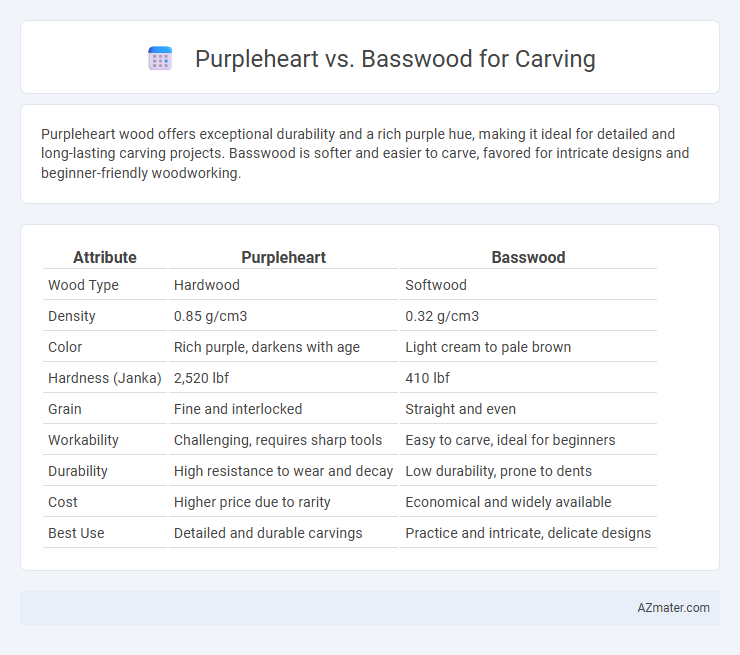Purpleheart wood offers exceptional durability and a rich purple hue, making it ideal for detailed and long-lasting carving projects. Basswood is softer and easier to carve, favored for intricate designs and beginner-friendly woodworking.
Table of Comparison
| Attribute | Purpleheart | Basswood |
|---|---|---|
| Wood Type | Hardwood | Softwood |
| Density | 0.85 g/cm3 | 0.32 g/cm3 |
| Color | Rich purple, darkens with age | Light cream to pale brown |
| Hardness (Janka) | 2,520 lbf | 410 lbf |
| Grain | Fine and interlocked | Straight and even |
| Workability | Challenging, requires sharp tools | Easy to carve, ideal for beginners |
| Durability | High resistance to wear and decay | Low durability, prone to dents |
| Cost | Higher price due to rarity | Economical and widely available |
| Best Use | Detailed and durable carvings | Practice and intricate, delicate designs |
Introduction to Purpleheart and Basswood for Carving
Purpleheart wood, known for its vibrant purple hue and exceptional hardness, offers durability and a fine, dense grain ideal for detailed carving projects requiring precision and strength. Basswood, favored among carvers for its soft texture, light color, and smooth, even grain, allows for easy carving and intricate detail work, making it especially suitable for beginners and fine sculptural pieces. Both woods serve different needs in carving: Purpleheart excels in toughness and visual impact, while Basswood provides ease of carving and a smooth finish.
Wood Hardness and Carving Difficulty
Purpleheart is significantly harder than Basswood, with a Janka hardness rating of approximately 2,520 lbf compared to Basswood's 410 lbf, making it more durable but tougher to carve. The dense, fine grain of Purpleheart presents a challenge for detail work and requires sharper tools and more effort, while Basswood's softness and fine, even texture make it ideal for intricate carving and beginners. Carvers seeking ease and precision often prefer Basswood, whereas those wanting durability and vibrant color might choose Purpleheart despite its carving difficulty.
Grain Structure and Workability
Purpleheart features a fine to medium grain with a straight to interlocked pattern, offering a dense and durable texture that holds intricate carving details well. Basswood has a uniform, fine grain with a consistently smooth texture, making it exceptionally easy to carve and ideal for detailed work. While Purpleheart demands sharper tools due to its hardness, Basswood provides superior workability, especially for beginners and delicate designs.
Tool Requirements and Maintenance
Purpleheart requires sharper, more durable tools due to its dense, hard texture, making high-quality carbide or diamond-tipped blades ideal for carving. Basswood's softer, fine-grained structure allows for easier cutting with standard steel carving tools, requiring less frequent sharpening. Tool maintenance for Purpleheart involves frequent sharpening and rust prevention because its hardness quickly dulls blades, whereas Basswood demands less upkeep, primarily routine cleaning and occasional blade honing.
Color and Aesthetic Appeal
Purpleheart wood stands out with its vibrant, deep purple hue that intensifies to richer shades over time, offering a unique and exotic aesthetic ideal for carving projects that demand striking visual impact. In contrast, Basswood features a pale, creamy color with a fine, even texture, providing a neutral and smooth surface that highlights intricate details and is favored for precision carving and ease of finishing. The choice between Purpleheart and Basswood hinges on whether the carver prioritizes bold, colorful appeal or subtle, classic elegance in the final piece.
Durability and Longevity of Carved Pieces
Purpleheart wood offers exceptional durability and natural resistance to wear, making carved pieces highly long-lasting and suitable for items exposed to heavy use or outdoor conditions. Basswood, while softer and easier to carve, has lower durability and is more prone to dents and scratches, which can reduce the longevity of the finished piece. For carvings requiring both strength and extended lifespan, Purpleheart provides a more robust option compared to Basswood.
Finishing Techniques for Each Wood
Purpleheart wood requires careful finishing to enhance its rich purple hue, often achieved by applying a clear, UV-resistant finish to prevent color fading and maintain its vibrant appearance. Basswood is favored for carving due to its smooth grain and ease of finishing with light stains or natural oils that highlight its pale, uniform texture without overpowering the delicate details. Both woods benefit from fine sanding before finishing; Purpleheart needs sealing to control its dense grain absorption, while Basswood's softness allows for quick and even finish penetration.
Cost and Availability
Purpleheart wood is generally more expensive and less readily available compared to Basswood, making it a pricier option for carving projects. Basswood is widely accessible and affordable, often favored by beginners and professionals for its softness and ease of carving. The higher cost of Purpleheart is due to its dense hardness and vibrant color, but limited supply can also impact project budgets.
Best Carving Applications for Purpleheart and Basswood
Purpleheart is ideal for detailed and durable carvings requiring a dense, hard wood that resists wear and maintains sharp edges, making it perfect for outdoor sculptures and high-traffic decorative items. Basswood, known for its soft, fine, and even grain, excels in intricate, smooth carvings such as relief carving, whittling, and beginner projects where ease of cutting and minimal grain interference matter. For best results, use Purpleheart for projects demanding strength and longevity, while Basswood suits delicate, fine-detail work and quick prototype carvings.
Final Comparison: Which Wood Suits Your Carving Needs?
Purpleheart offers exceptional durability and a striking deep purple color that darkens with exposure, making it ideal for carvers prioritizing longevity and vibrant aesthetics. Basswood is softer, easier to carve, and provides a smooth, fine grain, perfect for beginners or intricate detail work. Choose Purpleheart for robust, colorful projects requiring strength, while Basswood suits delicate, precise carvings and users seeking ease of workability.

Infographic: Purpleheart vs Basswood for Carving
 azmater.com
azmater.com